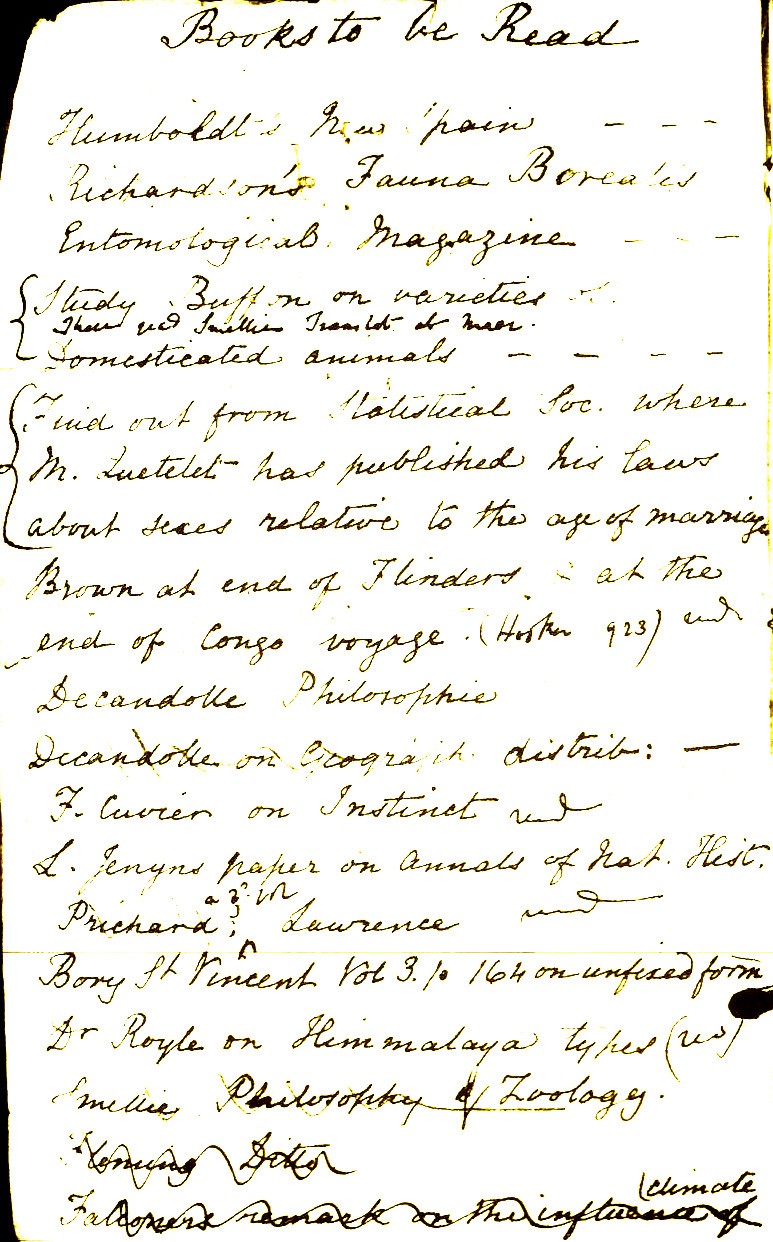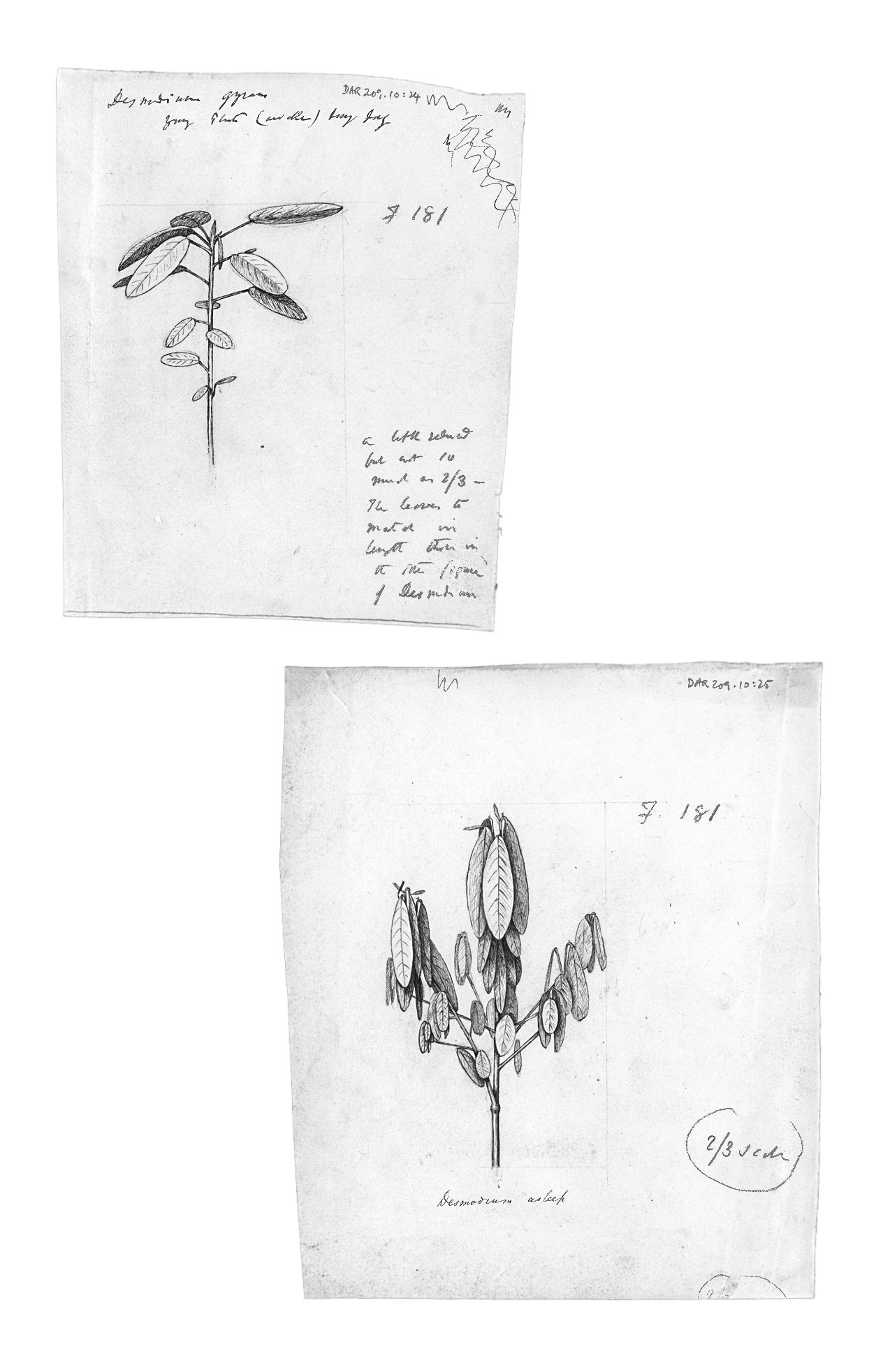From J. D. Hooker 14 November 1869
Summary
Describes how the offer of C.B. was made. He declined a knighthood. Murchison and Lyell are trying to get him made Knight Commander of the Star of India, but he does not think there is a chance. The Duke [of Argyll?] might do it, but does not like JDH’s Darwinism.
Next Presidency of Royal Society discussed: all (Brodie, the X Club botanists, et al.) are agreed on Lyell.
Everyone is disappointed with Nature.
What did CD think of "Huxley’s rhapsody on Goethe’s ditto" [Nature 1 (1869): 9–11]?
| Author: | Joseph Dalton Hooker |
| Addressee: | Charles Robert Darwin |
| Date: | 14 Nov 1869 |
| Classmark: | DAR 103: 35—8 |
| Letter no: | DCP-LETT-6988 |
Matches: 1 hit
- … Royal Society president in 1869, see Barton 1990 , p. 64. Hooker refers to Thomas Henry Huxley . Mary Elizabeth Lyell . The first issue of Nature , a ‘weekly illustrated journal of science’, was dated 4 November 1869. The publisher was Alexander Macmillan . For the criticism by X-Club members, including Hooker, of Nature , see Barton 2004 . The Academy was a monthly review of literature, science, and art, established in October 1869 (see letter …
2.19 Montford, bust at the Royal Society
Summary
< Back to Introduction Horace Montford’s marble bust of Darwin at the Royal Society, dating from 1898, derives from his bronze statue at Shrewsbury. It was normal for sculptors to re-use their models in this way for the creation of busts and…
Matches: 1 hits
- … < Back to Introduction Horace Montford’s marble bust of Darwin at the Royal Society, …

Climbing plants
Summary
Darwin’s book Climbing plants was published in 1865, but its gestation began much earlier. The start of Darwin’s work on the topic lay in his need, owing to severe bouts of illness in himself and his family, for diversions away from his much harder book on…
Matches: 1 hits
- … Darwin’s book Climbing plants was published in 1865, but its gestation began much earlier. The …

Darwin’s reading notebooks
Summary
In April 1838, Darwin began recording the titles of books he had read and the books he wished to read in Notebook C (Notebooks, pp. 319–28). In 1839, these lists were copied and continued in separate notebooks. The first of these reading notebooks (DAR 119…
Matches: 1 hits
- … In April 1838, Darwin began recording the titles of books he had read and the books he wished to …

Darwin in letters, 1865: Delays and disappointments
Summary
The year was marked by three deaths of personal significance to Darwin: Hugh Falconer, a friend and supporter; Robert FitzRoy, captain of the Beagle; and William Jackson Hooker, director of the Royal Botanic Gardens, Kew, and father of Darwin’s friend…
Matches: 1 hits
- … In 1865, the chief work on Charles Darwin’s mind was the writing of The variation of animals and …

Darwin in letters, 1863: Quarrels at home, honours abroad
Summary
At the start of 1863, Charles Darwin was actively working on the manuscript of The variation of animals and plants under domestication, anticipating with excitement the construction of a hothouse to accommodate his increasingly varied botanical experiments…
Matches: 1 hits
- … At the start of 1863, Charles Darwin was actively working on the manuscript of The variation of …

Books on the Beagle
Summary
The Beagle was a sort of floating library. Find out what Darwin and his shipmates read here.
Matches: 1 hits
- … ‘Considering the limited disposable space in so very small a ship, we contrived to carry more …
3.16 Oscar Rejlander, photos
Summary
< Back to Introduction Darwin’s plans for the illustration of his book The Expression of the Emotions in Man and Animals (1872) led him to the Swedish-born painter and photographer, Oscar Gustaf Rejlander. Rejlander gave Darwin the notes that he had…
Matches: 1 hits
- … < Back to Introduction Darwin’s plans for the illustration of his book The …

Darwin in letters, 1874: A turbulent year
Summary
The year 1874 was one of consolidation, reflection, and turmoil for Darwin. He spent the early months working on second editions of Coral reefs and Descent of man; the rest of the year was mostly devoted to further research on insectivorous plants. A…
Matches: 1 hits
- … The year 1874 was one of consolidation, reflection, and turmoil for Darwin. He spent the early …
1.18 John Collier, oil in Linnean
Summary
< Back to Introduction By 1881 it was clear to Darwin’s intimates that he was increasingly frail, and that, as he approached death, he had finally escaped from religious controversy to become a heroic figure, loved and venerated for his achievements…
Matches: 1 hits
- … < Back to Introduction By 1881 it was clear to Darwin’s intimates that he was …

Darwin in letters, 1860: Answering critics
Summary
On 7 January 1860, John Murray published the second edition of Darwin’s Origin of species, printing off another 3000 copies to satisfy the demands of an audience that surprised both the publisher and the author. It wasn't long, however, before ‘the…
Matches: 1 hits
- … On 7 January 1860, John Murray published the second edition of Darwin’s Origin of species , …

Conrad Martens
Summary
Conrad Martens was born in London, the son of an Austrian diplomat. He studied landscape painting under the watercolourist Copley Fielding (1789–1855), who also briefly taught Ruskin. In 1833 he was on board the Hyacinth, headed for India, but en route in…
Matches: 1 hits
- … Conrad Martens was born in London, the son of an Austrian diplomat. He studied landscape painting …

Darwin in letters, 1868: Studying sex
Summary
The quantity of Darwin’s correspondence increased dramatically in 1868 due largely to his ever-widening research on human evolution and sexual selection.Darwin’s theory of sexual selection as applied to human descent led him to investigate aspects of the…
Matches: 1 hits
- … On 6 March 1868, Darwin wrote to the entomologist and accountant John Jenner Weir, ‘If …

Darwin in letters, 1880: Sensitivity and worms
Summary
‘My heart & soul care for worms & nothing else in this world,’ Darwin wrote to his old Shrewsbury friend Henry Johnson on 14 November 1880. Darwin became fully devoted to earthworms in the spring of the year, just after finishing the manuscript of…
Matches: 1 hits
- … ‘My heart & soul care for worms & nothing else in this world,’ Darwin wrote to his old Shrewsbury …

Darwin in letters, 1871: An emptying nest
Summary
The year 1871 was an extremely busy and productive one for Darwin, with the publication in February of his long-awaited book on human evolution, Descent of man. The other main preoccupation of the year was the preparation of his manuscript on expression.…
Matches: 1 hits
- … The year 1871 was an extremely busy and productive one for Darwin, seeing the publication of his …

Experimenting with emotions
Summary
Darwin’s interest in emotions can be traced as far back as the Beagle voyage. He was fascinated by the sounds and gestures of the peoples of Tierra del Fuego. On his return, he started recording observations in a set of notebooks, later labelled '…
Matches: 1 hits
- … Darwin’s interest in emotions can be traced as far back as the Beagle voyage. He was fascinated by …



